Know your glues so the things you need to stick together stay stuck.
Our editors and experts handpick every product we feature. We may earn a commission from your purchases.Learn more.
Know your glues so the things you need to stick together stay stuck.
Our editors and experts handpick every product we feature. We may earn a commission from your purchases.Learn more.
 via amazon.com
via amazon.com
This was the first glue many people encountered as children. It’s the translucent, gelatinous goo that teachers give preschoolers to glue together their paper creations.
In Japan, people have long used a pasty version of mucilage — an organic and natural type of craft glue — to glue paper to shoji screens. Mucilage is a polysaccharide produced by living plants, and it’s edible. Boomers might remember mucilage from their childhood; it was the preferred adhesive for preschoolers before non-toxic synthetic versions became available.
Craft glue, whether mucilage or synthetic, bonds paper but not much else, and it loses its bonding capability when it gets wet.
Building your own shoji screens? Use Yasutomo Nori Paste to bind the paper. Preparing supplies for a preschool class? Consider Clear Gel Tacky Glue.
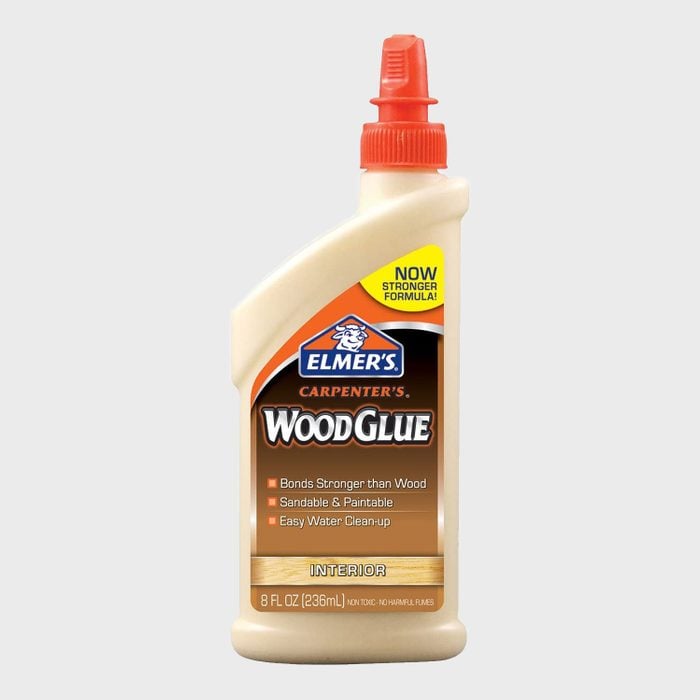 via amazon.com
via amazon.com
Sometimes called white glue and carpenter’s glue, wood glue is often off-white or even yellow. More correctly known as polyvinyl acetate (PVA) adhesive, you’ll find this thick white liquid almost everywhere. Although it’s often characterized as all-purpose, it really only works for wood, paper and other porous materials. It won’t bond metal, glass or plastic.
This is the go-to adhesive for woodworkers. It can bond two pieces of wood to each other and heal cracks and splits, although you usually need clamps for the full benefit of its holding power. It’s water-soluble when wet and waterproof when dry, but only certain formulations are suitable for wet conditions.
The best known brands are Elmer’s and Titebond. Polyurethane adhesive pioneer Gorilla also manufactures wood glue.
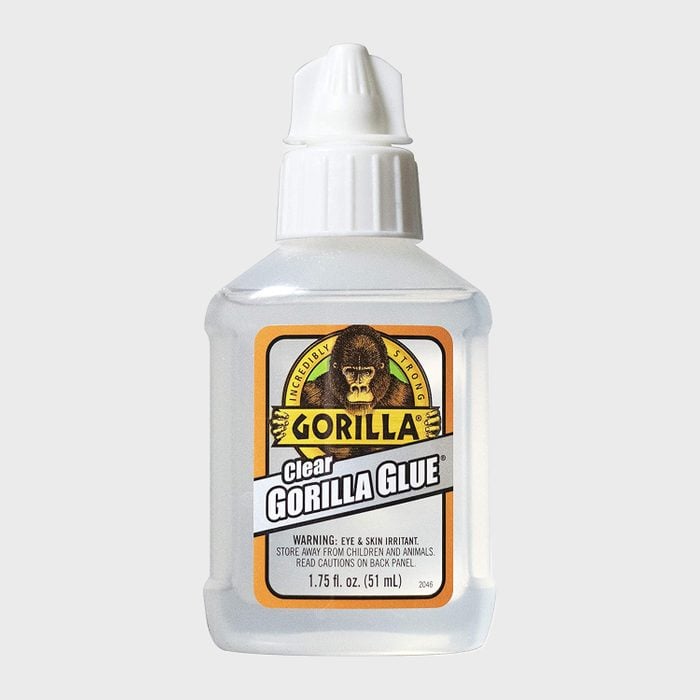 via amazon.com
via amazon.com
Gorilla introduced polyurethane adhesive to the market, and the brand name is now virtually synonymous with this type of adhesive.
Gorilla Glue is one of a class of polyurethane adhesives. Because it has only one part, it’s known in the industry as a 1K PU adhesive. Two-part formulations, known as 2K PU adhesives, are much stronger — strong enough to hold landscape rocks together.
A 1K PU like Gorilla Glue can bond wood, stone, metal, plastic and other materials. It forms a flexible, waterproof bond, and woodworkers often use it instead of wood glue to assemble wood projects. In construction, it’s great for securing subfloors to joists and wall panels to studs.
Polyurethane glue needs moisture to cure and it expands as it dries. That’s good because it fills crevices and pores, but not so good in that it often foams out of the joint. Gorilla Glue addresses this problem by offering a non-foaming formulation. Once it cures, polyurethane glue is suitable for wet conditions, and you can paint over it. Titebond also manufactures polyurethane glue.
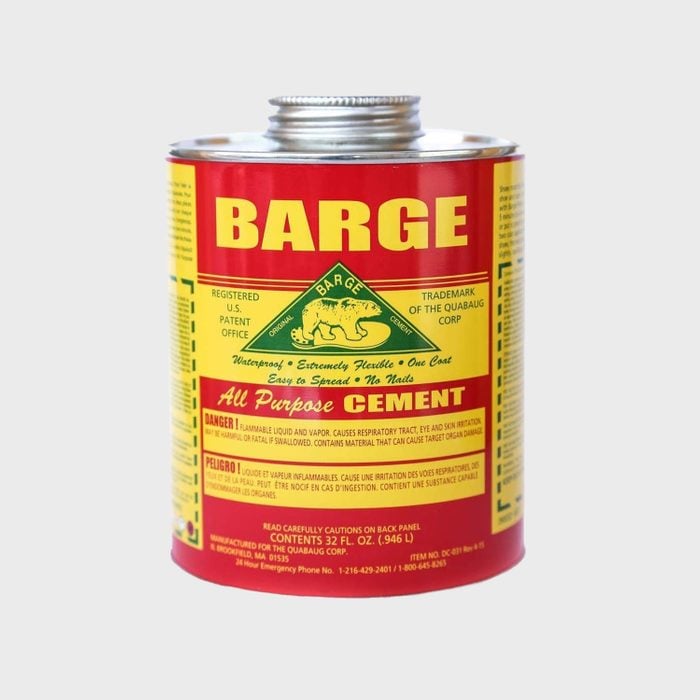 via amazon.com
via amazon.com
If you’re attaching plastic laminate to a countertop, you don’t want to wait for glue to set because the surfaces you are joining could move. In that case, contact cement is the adhesive for you.
It’s basically neoprene rubber dissolved in a solvent such as acetone or toluene. Apply contact cement to both surfaces you’re joining with a brush or roller. Allow the solvent to evaporate, which takes from five to 10 minutes. Then press the surfaces together, and the rubber instantly forms a permanent bond. It’s not a glue for making spot repairs because it needs a large surface area to work properly.
When shoe repair pros need contact cement, they often reach for Barge. Kitchen remodelers are more likely to use Dap Weldwood.
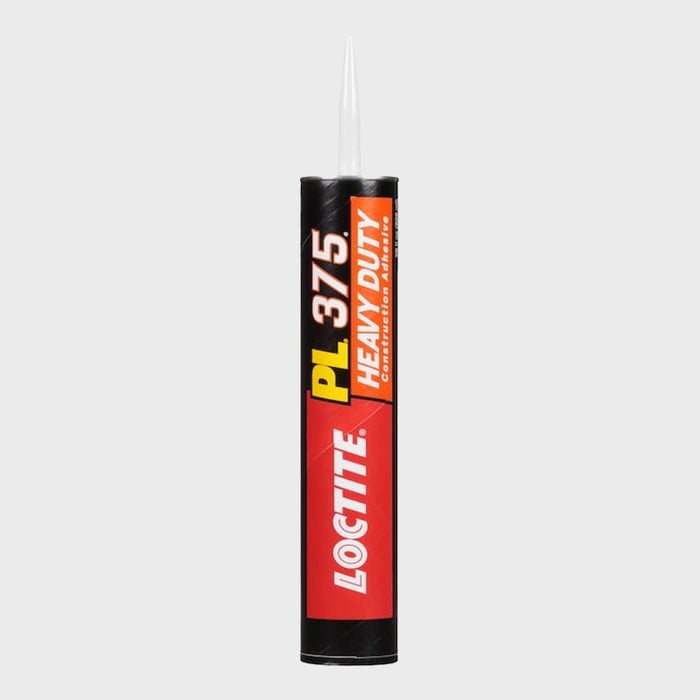 via lowes.com
via lowes.com
Construction adhesive is a staple on building sites. It’s used for bonding subfloors to joists, wall panels to studs and much more. It comes in a tube that fits in a caulk gun. It may contain acrylic resin, polyurethane monomers, styrene-butadene rubber or a combination of adhesive chemicals.
Apply construction adhesive to surfaces you want to join the same way you apply caulk. Construction adhesive remains flexible when dry, allowing some give between the joined surfaces. It bonds wood, concrete, metal, plastic and many other materials.
Around the house, use it to affix wall hooks and drawer handles, repair loose gate latches, stick loose tiles back in place and even attach soap dishes to wet shower walls.
Tests have shown not all construction adhesives work equally well in cold weather or wet conditions. Loctite PL 375, a water-soluble latex product, proved to have the most holding power but failed in freezing and wet conditions.
Loctite Power Grab, also latex, isn’t as strong but can withstand cold and moisture. Fuze-It from Liquid Nails, a name synonymous with construction adhesive, combines strength with cold and moisture resistance.
 via amazon.com
via amazon.com
When you need to reattach a shoe heel, or any repair that calls for more holding power than contact cement, you need a similar formulation — rubber cement— that comes in a tube.
The best known example is Shoe Goo. Like contact cement, it’s styrene rubber dissolved in toluene, but you can squirt it into small areas. When it dries, the bond is flexible, virtually unbreakable and waterproof. Use rubber cement to bond rubber, leather, glass, ceramic and many other materials.
Elmer’s makes a comparable rubber cement that comes in a bottle with its own brush.
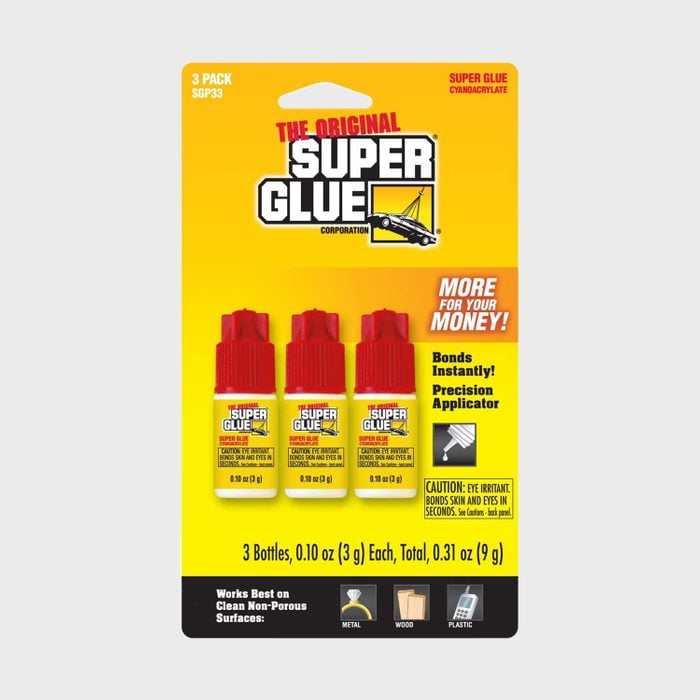 via amazon.com
via amazon.com
Most people know this adhesive by the brand names Super Glue or Krazy Glue. Cyanoacrylate (CA) glue joins ceramic, glass, metal, wood and many other materials, and a little goes a long way. It dries quickly and also bonds to skin, so be careful.
CA glue reacts to moisture in the air to form super-strong polymers with a tensile strength (resistance to being pulled apart) approaching 4,000 pounds per square inch (psi). Because it sets quickly, you usually don’t need clamps to hold pieces together, so it’s ideal for many household repairs.
Although it forms a strong bond, CA glue doesn’t hold up well under external stress and can shatter under impact. It’s generally reserved for small repairs like decorative ceramics and glassware and other non-utilitarian household items. Some formulations are too thin to fill wood pores, but gel-types work. Gorilla Glue Gel is one of the better known products.
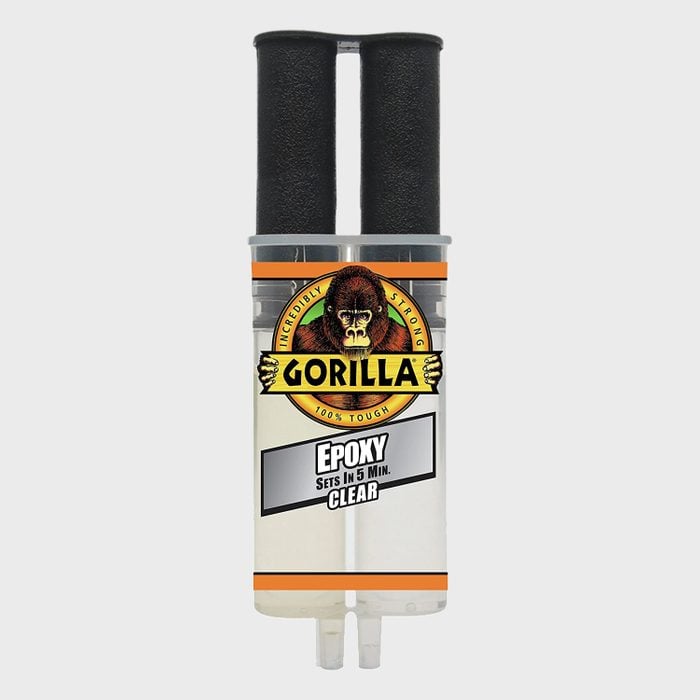 via amazon.com
via amazon.com
Epoxies are long chains of carbon molecules linked to other elements such as hydrogen, oxygen or nitrogen. When you mix an epoxy resin with a hardening catalyst, the resulting chemical reaction forms one of the strongest adhesives there is.
Epoxy adhesive typically comes in a double-barreled tube that keeps the resin and hardener separate until you’re ready to use it. Once you mix the components in equal amounts, you have five to 30 minutes before it stiffens. Epoxy will bond most materials, although different formulations work specifically for metal, wood, concrete and plastic. There’s also one for marine use.
Gorilla makes a five-minute epoxy for rush jobs. If you have more time, CecCorp C-poxy takes 30 minutes to cure and makes a much stronger bond.
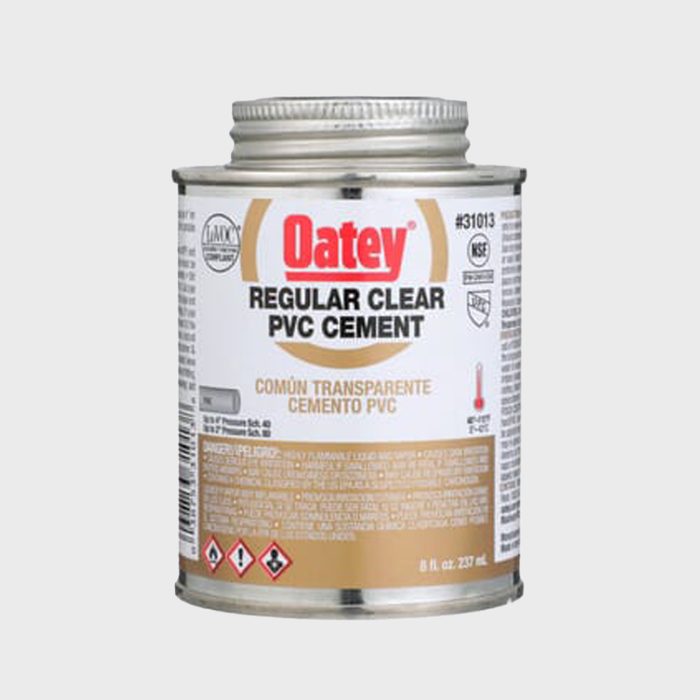 via homedepot.com
via homedepot.com
When plumbers need to join plastic pipe to plastic fittings, they use solvent weld glue. As the name suggests, it’s a mixture of solvents that include methyl ethyl ketone, acetone and other chemicals with long names. By itself, it isn’t strong. If you get any on your hands, you can usually just peel it off.
There are two types of solvent weld glue: a clear one for PVC and a black one for ABS pipe. Both work by melting the plastic temporarily so a pipe can fuse to the fitting where it’s inserted.
Solvent weld glue comes in a can with its own brush, and should be applied liberally. Oatey is the leading manufacturer of PVC and ABS pipe cement. The company also makes purple primer for PVC pipe before applying the cement.
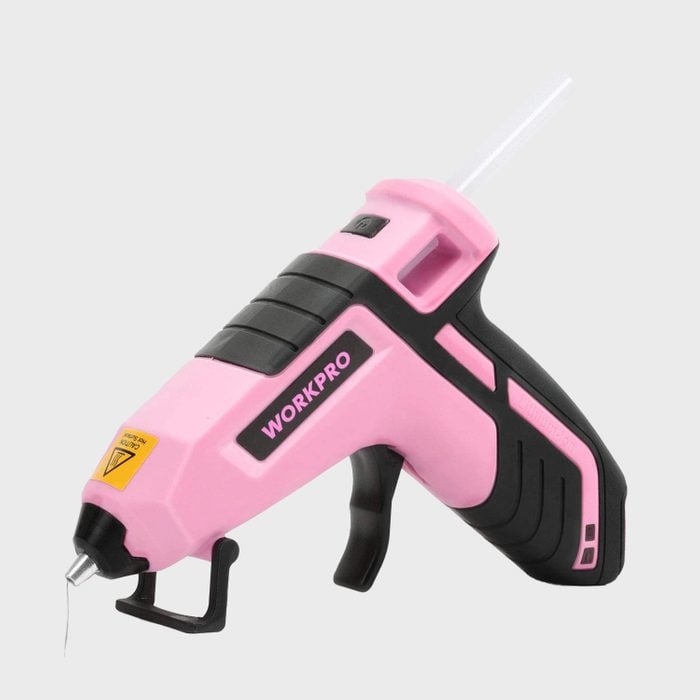 via amazon.com
via amazon.com
Woodworkers and craftspeople sometimes need a glue that bonds instantly. When they do, they often reach for a hot-melt glue gun.
The glue itself is a thermoplastic resin that comes in sticks from 1/4- to 3/4-in.-dia. The gun heats the glue stick to the melting point and feeds it through a nozzle, making it easy to apply to wood, felt, cardboard, glass and other crafty materials.
Although hot-melt glue makes a strong bond, it isn’t permanent, because you can re-melt the glue by heating it. This is an advantage in a craft setting when you need to bond two things temporarily during the assembly of a more complex project.
Among the many manufacturers of hot-melt glue sticks and guns, Workpro is one of the better-known names. Ryobi sells a hot-melt glue kit that works with its 18-volt ONE+ battery system.
Although it’s used more often as a sealant for moisture-prone areas, silicone caulk is actually a strong adhesive. It can bond glass to itself or to another surface. You can use it to bond porcelain, ceramic, stone, wood and many other materials. Plumbers sometimes use it to adhere undermount sinks to countertops.
Anyone who has ever tried to remove old silicone caulk from bathroom surfaces knows how well it sticks. Silicone adhesive comes in standard caulking tubes or squeeze tubes. You apply it like caulk, in long, continuous runs (painters call these beads), usually around the edges of whatever you’re adhering to something else. Popular brands include GE and Gorilla. (Is there any glue that Gorilla doesn’t make?)
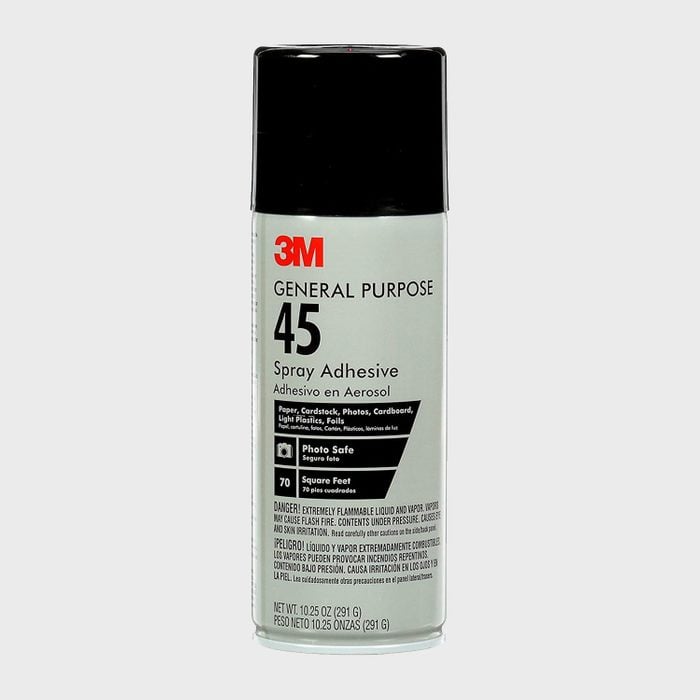 via amazon.com
via amazon.com
A type of contact cement, spray adhesive is a favorite of crafters and hobbyists. Spray adhesives come in various strengths. The weakest works for bonding paper, foam and other lightweight materials, while stronger formulations bond leather, carpeting, wood trim and even some automotive parts.
Spray adhesives are easy to use and dry clear. Be sure to use a respirator. Depending on the product, they contain a host of flammable solvents you don’t want to inhale, including acetone, butane and propane. Avoid open flames as well.
Among the more popular brands are 3M, Loctite and, you guessed it, Gorilla.
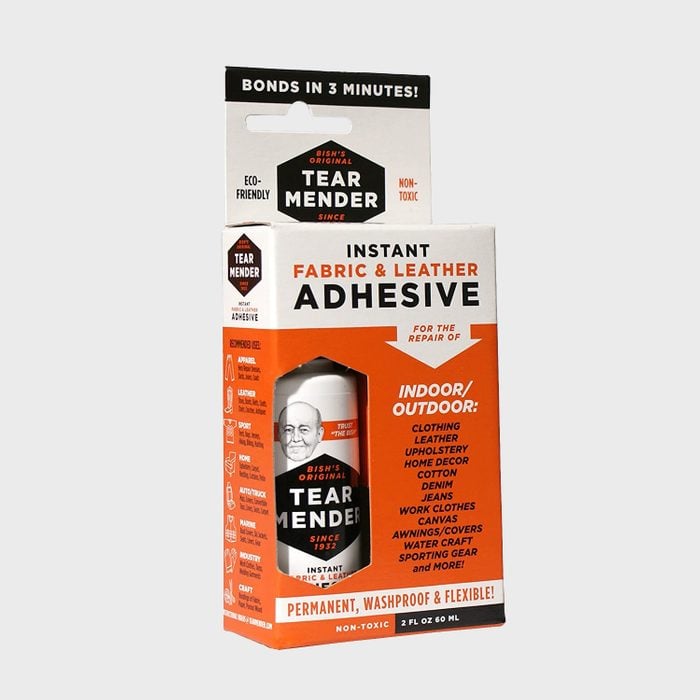 via amazon.com
via amazon.com
Available in squeeze bottles and spray cans, fabric glue is specially formulated to bond securely and remain flexible. It thus creates permanent hems and mends in all types of materials, including denim, cotton, canvas, leather and more. It’s similar to spray adhesive. Depending on formulation, it can make a waterproof and permanent bond or a temporary one that makes sewing easier.
Fabric glue is clear, non-staining and won’t stiffen fabric. Among the leading brands are Tear Mender, which forms a permanent bond in three minutes; Roxanne Glue Baste-It, which forms a temporary bond that can be separated and repositioned as necessary; and waterproof Gorilla Fabric Glue, the top choice for adhering sequins and jewelry to fabric.
 via amazon.com
via amazon.com
Similar to craft glue and also nontoxic, glue sticks are more kid-friendly because there’s nothing to spill. The main ingredient is a water-soluble polymer called polyvinylpyrolidone (PVP), which forms a weak bond suitable for sheets of paper.
Glue sticks are great for affixing labels to documents, making sticky notes for the refrigerator, or sealing envelopes that lost their stickiness. The adhesive in some sticks such as Elmer’s Re-Stick, is only strong enough to hold bits of paper together until you pull them apart. Some brands, like Avery Permanent Glue Stic, feature a longer-lasting adhesive.
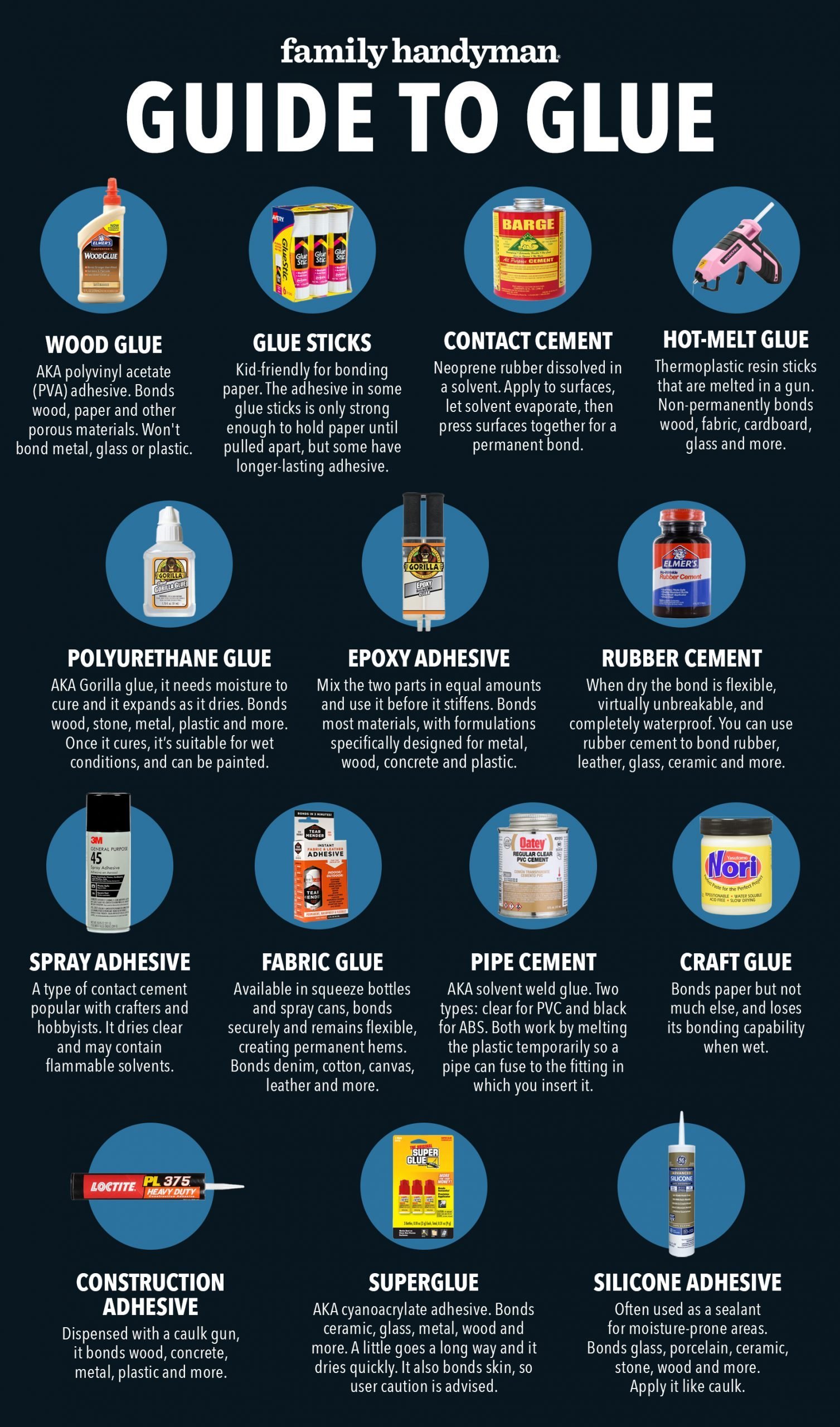 Family Handyman, via retailers (14)
Family Handyman, via retailers (14)When picking the right glue for the job, you must know what that job entails. More specifically, it means you need to know what kind of things you are gluing together to get the right bond for the job. Here are some common uses and things to look out for:
You may notice that a typical tube of super glue is quite small, whereas a construction glue might come in a much larger container. This is indicative of the kinds of jobs these adhesives are used for. If you have a small job, a small tube of glue might do just fine. But a larger job requires more glue. Similarly, you don’t want to spend money on a huge tub of adhesive for a tiny job, as you’ll end up with too much leftover (and potential waste).
It’s best to assume that gluing something, however large or small the project, is a permanent solution. However, some glues are easier to dissolve and remove than others. Craft glue, for instance, is a lot more forgiving than something with an extremely strong bond, like epoxy. If there’s a chance you’ll need to ever remove your glue, it may be worth opting for a glue that can be relatively easily removed.
Different glues react differently when exposed to humidity and/or high temperatures. Before settling, ask yourself what elements your glue will be exposed to regularly and purchase your glue based on those factors. Your bond will stay tight and secure even under those conditions.
This guide intends to give readers and those interested in DIY projects a comprehensive introduction to the different types of glue widely available on the market, so I tried to include the full picture. However, it also behooves me to provide the best examples of each type of glue. So, along with my personal and professional expertise, I paid special attention to the glues’ effectiveness, popularity, availability, budget-friendliness and several other factors. Then, I put together this collection representing the best of the best.
With an international career in home design and building stretching over four decades, I have tremendous experience with almost all glue types imaginable. I’ve been writing about the process of testing and reviewing products for about the same amount of time. It would be safe to say that I am certainly a glue expert.
Epoxy adhesives typically have the strongest tensile strength, especially the single component heat curable variety. However, it’s worth noting that the strength also makes it the hardest to remove or clean, especially once the curing period is over—just make sure you’ve got everything where you want it and don’t want to take it apart pretty much ever again if you’re going to use this kind of glue. Furthermore, just because this is the strongest glue doesn’t necessarily mean it’s the right glue for the job. Apply the knowledge shared above to pick the right glue for your projects.
While not always the right glue for the job, regular old household superglue creates one of the strongest bonds. It’s also one of the most widely available, easy to get and affordable, making it among the best all-purpose glues around.
While it adheres to most surfaces, Gorilla Glue is unsuitable for polyethylene, polypropylene, Teflon or bitumen (asphalt) surfaces.
While it can serve various uses, rubber cement is especially popular in making crafts—partially because of its adhesive strength but also because it is forgiving and doesn’t leave residue behind. It is also capable of patching small holes in other rubber surfaces, like the soles of athletic shoes, though we recommend this more as a temporary fix (it is better to replace a shoe entirely if it has holes in the sole).
Solvents, like rubbing alcohol or acetone, can break down some types of glue. Furthermore, glue can be weakened by repeated or constant stress. Time may also break down glue (though sometimes glue takes longer to break down than the material to which it adheres).